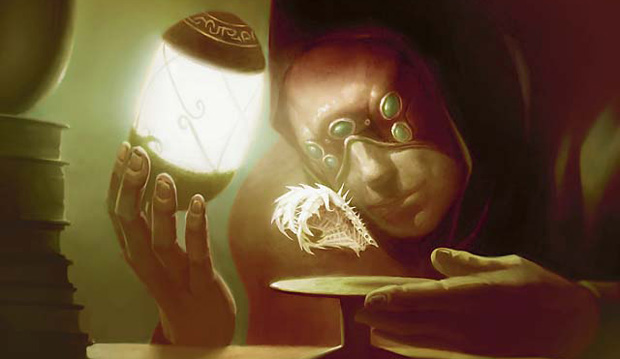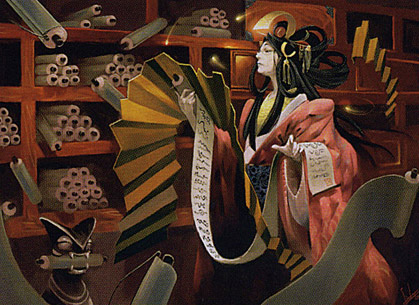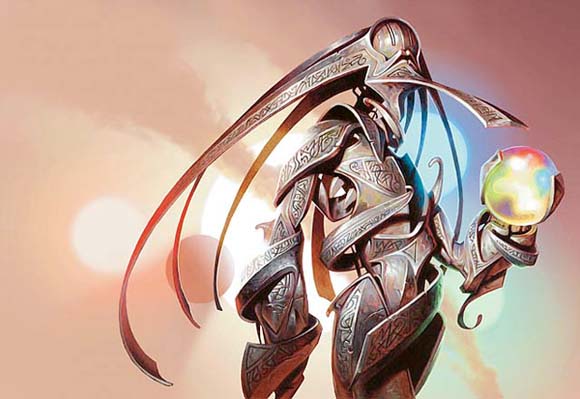Hola, world-weavers! Last time, we talked about how we tweaked the design skeleton yet again. And we're probably about to do it again. Does it seem like we just keep shuffling things around in a little rut in this grand scheme of a design process? That's not how I see it. I imagine these articles I write to be like me, as the lead designer of the four-color set, holding a design meeting every week to discuss the set. However, members of the design team attending these meetings are in a constant flux! It's a different number of people present at every meeting, which means some things don't come into light until later when "Designer X" comes out and makes an observation that changes everything (not really everything)! Then we (gladly) take a step back to focus on a vital part of the set or go back to the drawing board completely.
I wouldn't say that, today, we're going back to erase the metaphorical whiteboard containing scribbles of everything we've done, but I would say that we're going to, once again, adjust the design skeleton. But, we're at a major junction, and I don't know which route we should take. What's happening for sure is we're going to simplify, once more, the kinds of multicolor cards in the set.
Conjunction Junction...

Presently, we have a mix of hybrid, gold, and hybrid-gold cards. The plan was to have two-color gold and hybrid, four-color hybrid-gold and gold, and four-color anti-mana cards. These are what make up the multicolor cards, and that might be too complex right now. We need to trim some fat and KISS (Keep It Simple, Stupid). So, there's two possible routes: We stick with traditional gold cards, or we go for all-hybrid. Both possibilities would take the set into different directions.
If we go gold, we're going to lose the flexibility of hybrid. There will need to be heavy mana-fix support (but also making sure that the mana-fixers don't accidentally encourage going five colors). We shouldn't do anti-mana since that's more of a "super hybrid" mechanic. We could do hybrid for one small part, and that's to make four-color cards with three mana symbols (a la Esper Stormblade, except with one more traditional colored mana). Obviously, Alara Reborn did it.
And then if we go hybrid, we won't need mana-fixers. In fact, we might need the four-color mechanic to do some support in discouraging players from going completely five color! Well, this didn't really happen as much in Shadowmoor because there was both an encouragement of going monocolor or two-color, and there were only two-color cards. This set would probably have to feature more-than-two color hybrids. You know, like, four-color hybrids. Except, done better than what was proposed with that one card in the first article of this series (Don't know what I'm talking about? Good). Also, anti-mana would be a superbly natural fit!
...What's Your Function?
You know, there's also another consideration. This mysterious four-color mechanic that I keep saying will be in the set could influence whichever one we decide to choose. I'm going to list a bunch of possible four-color mechanics and go over what's so great and not-so-great about them. The ones listed here, I believe, are just the tip of the iceberg of possibilities. Here we go.

(You'll see that I list mechanics in almost identical form. This is because the wording needs to be different depending on the type of effect. It's a templating thing. See the difference between Auriok Sunchaser and Concussive Bolt. There's even more variation when you look at Galvanic Blast.)
If four nonCOLOR colors are among permanents you control and cards in your graveyard, EFFECT
As long as four nonCOLOR colors are among permanents you control and cards in your graveyard, EFFECT
The advantage of this mechanic is that it hoses the strategies of splashing a fifth color in your deck for instants/sorceries (removal). The disadvantage of this mechanic is that it's way too easy to activate and keep activated while it's way too hard for your opponent to disrupt this mechanic from being active. The effect this has on hybrid is that it restricts your hybrid choices from even flirting with the fifth color, even if you were going totally honest and straight four colors. This type of effect seems to marry well with gold.
If four nonCOLOR colors are among permanents you control, EFFECT
As long as four nonCOLOR colors are among permanents you control, EFFECT
Ah, much simpler. I like it. However, it allows splashes for fifth colors. Perhaps if the set is designed to make it really hard to go five colors. This includes how mana-fixing is designed. Also, it's easier for your opponent to disrupt, which is good. This turns hybrid from being too good from the previous mechanic to being a valuable commodity for keeping this mechanic activated while not straining your mana base. Especially when you're going through the trouble of achieving four colors and somebody goes for one of your crucial creatures' throats.

If COLOR is not a color among permanents you control and cards in your graveyard, EFFECT
As long as COLOR is not a color among permanents you control and cards in your graveyard, EFFECT
This isn't cool. The set then becomes more about swearing off a color than about four colors. It even rewards monocolored decks for being monocolored. The counting of cards in the graveyard keeps you swearing off that color, but it's too easy to just not include in your deck. No bueno. This goes for the other two parallel iterations, so I won't even go into those.
Imbue (Whenever you cast a spell, for each of its colors, if this has no charge counters on it with the same color, put a charge counter with the same color on this.)
EFFECT as long as exactly four colors are among counters on it (CARDNAME).
EFFECT if there are exactly four colors among counters on CARDNAME (it).
Whoa, lots of stuff going on here. First of all, colored counters. Jay and Jules last week had played around with ideas for using colored counters for mana-fixer designs. Since that was limited in the amount of cards that would be appearing in the set, it was more O.K. than the usual amount of blasphemy. But this is for a major mechanic permeating throughout a whole block. Colored counters?! Are we crazy? There could be potential difficulties with keeping track of the colors, which would lead to memory issues and probably cheating, accidental or on purpose. Then again, every single one of these cards could use Jay's idea of separating the counters by having art that separated the colors for you, so you'd simply place a counter where the appropriate color was. But what if somebody bumped the table? Or you attack with a creature with this too excitedly?

Anyway, that's the first thing. The second thing is that it's separating the mechanic into two abilities. One for keywording (so cards such as rares could just include one word instead of the whole mumbo-jumbo) and one for the ability that makes he mechanic actually work as something useful. It's kinda weird. This hoses permanents with this mechanic in the late-game because you'll be short on spells. That's where hybrid comes in (and anti-mana, of course) to save the day. At least double the color in the same amount of cards as multicolor! There are the same benefits for gold, too; except, it's harder to pull off because it's just not hybrid. Fear not, gold. Mana-fixing has your back.
...Connecting Words, Phrases, and Clauses
It's a short article this week. I'll have to further discuss this next week! However, this could be a good thing. Perhaps; you, reader, would make an excellent case for why we should go gold or hybrid, or vice versa. Or maybe we should just stick with gold and hybrid, the way we've been doing it all along. Then you'll have saved us all from a whole heap of figuring, and we move on to figuring out other things based off that decision. Something like that. Anyway, I'll see you next week!
Cheers,
Brad


No comments:
Post a Comment